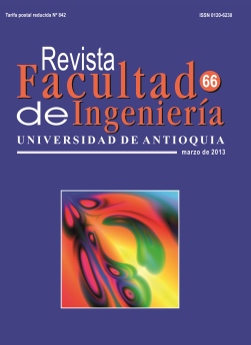Ricatti stochastic filter as an estimator
DOI:
https://doi.org/10.17533/udea.redin.15234Keywords:
second probability moment, Ricatti estimation, convergence, instrumental variable, least squares methodAbstract
The Ricatti stochastic digital filter as an estimator is based on a first differences order model with uncorrelated innovation properties bounding the spatial operation region with two auxiliary equations. This permits optimal results having the traditional inversion instead of the pseudo-inverse strategy. The stationary conditions and uncorrelated trajectories were the tools applied in adaptive estimation and identification integrated form. In spite of the blackbox form observing the output system, the parametre and identification simulation achieved a great convergence rate in agreement with functional error. It was built considering the identification second probability moment defined as the difference between the desired signal and the output filter response. The parametres estimated were inside the unit circle and had a great advantage because the primitive solution depends on their values.
Downloads
References
A. Novales. Análisis de Regresión Lineal. Universidad Complutense. Disponible en: http://www.ucm.es/info/ecocuan/anc/ectriaqf/Analisis%20de%20Regresion.pdf. pp. 4-116. Consultado en septiembre de 2010.
E. Alameda, H. Ruiz, P, Tienda, M. Carrión. Un nuevo algoritmo tipo gradiente estocástico para identificación ciega de canales. Universidad de Coruña. Vol. 6. 2003. pp. 1-4. Disponible en: http://ursi2003.udc.es/fichas/ficha1284.html.
H. Yanga, X. Changa, D. Liua. Improvement of the Liu. “Estimator in Weighted Mixed Regression Communications in Statistics”. Theory and Methods. Vol. 38. 2009. pp. 285-292. DOI: https://doi.org/10.1080/03610920802192513
J. Urdánoz. “Medición de la desproporcionalidad electoral: una crítica a los mínimos cuadrados” Revista Española de Investigaciones Sociológicas. No. 115. 2006. pp. 271-273.
H. López. “Análisis e implementación de un Sistema de Control Adaptativo en Tiempo Real basado en Microcomputador”. Tesis de doctorado. Universidad de Oviedo. Departamento de ingeniería eléctrica, electrónica de computadoras y sistemas. Oviedo, Asturias, España. 1989. pp. 14-19.
S. Sezginer, P. Bianchi. “Asymptotically Efficient Reduced Complexity Frequency Offset and Channel Estimators for Uplink MIMO-OFDMA”. Systems Signal Processing, IEEE Transactions. Vol. 56. 2007. pp. 964-979. DOI: https://doi.org/10.1109/TSP.2007.907914
A. Fernández. Cancelación de Eco. Universidad de la Republica Montevideo Uruguay 2003. http://www.fing.edu.uy/iie/ense/asign/tes/materiales/monografias/Cancelacion_de_Eco_J_Fernandez.pdf. Consultada en enero de 2012.
D. Vecchia. Una Estructura en Cascada FIR para Predicción Lineal Adaptiva. Universidad de la Republica Montevideo Uruguay (2003). http://www.fing.edu.uy/iie/ense/asign/tes/materiales/monografias/Cancelacion_de_Eco_J_Fernandez.pdf. Consultada el 2 enero de 2012.
I. Morales, M. González. “Comparación de las técnicas de análisis de variancia y regresión lineal múltiple: aplicación a un experimento de almacenamiento de mango”. Agronomía Costarricense. Vol. 27. 2003. pp. 45-53.
J. Medel, M. Zagaceta. “Estimación-Identificación como filtro digital integrado: descripción e implementación recursiva”. Revista Mexicana de Física. Vol. 56. 2010. pp. 1-8.
V. Valerii, S. Fedorov, L. Leonov. “Parameter Estimation for Models with Unknown Parameters in Variances, Communications in Statistics”. Theory and Methods. Vol. 33. 2006 pp. 2627- 2657. DOI: https://doi.org/10.1081/STA-200037917
F. Kwun, C. Wen. “An M-Estimator for Estimating the Extended Burr Type III Parameters with Outliers Communications in Statistics”. Theory and Methods. Vol. 3. 2010. pp. 304-322. DOI: https://doi.org/10.1080/03610920903411234
D. Belie, F. Melkebeek. “Seamless integration of a low-speed position estimator for IPMSM in a current-controlled voltage-source inverter”. 1st Symposium on Sensor-less Control for Electrical Drives (SLED). Dept. Electr. Energy, Syst. & Autom., G Univ. Ghent, Belgium. 9-10 july 2010. pp.50-55. DOI: https://doi.org/10.1109/SLED.2010.5542804
F. Antreich, J. Nossek, G. Seco, A. Lee. “Time delay estimation in a spatially structured model using decoupled estimators for temporal and spatial parameters”. Smart Antennas, WSA International ITG on Digital Object Identifier. Wessling, Germany. 26-27 Feb. 2008. pp. 16-20. DOI: https://doi.org/10.1109/WSA.2008.4475531
C. Breithaupt R. Martin. “Analysis of the Decision-Directed SNR Estimator for Speech Enhancement with respect to Low-SNR and Transient Conditions”. IEEE Transactions on Audio Speech and Language Processing. Vol. 19. 2010. pp. 277-289. DOI: https://doi.org/10.1109/TASL.2010.2047681
C. Jian, J. Huang, C. Zhi. “Forecasting of target air route based on weighted least squares method”. Control Conference 29th Chinese. Huizhou, China. 29- 31 July 2010. pp. 3144-3147.
L. Ma, C. Cao, N. Hovakimyan, C. Woolsey, H. Guoqiang. “Estimation of an Affine Motion American Control”. Proceedings of the American Control Conference. St. Louis, MO, USA. July 2009. pp. 5058- 5090. DOI: https://doi.org/10.1109/ACC.2009.5160177
D. Jones, S. Appadwedula, M. Berry, M. Haun, D. Moussa, D. Sachs. Adaptive Filtering: LMS Algorithm. Disponible en: http://cnx.org/content/m10481/2.13/. Consultado en febrero de 2012.
J. Medel, M. Zagaceta. “Estimador de Parámetros para Sistemas de Orden Superior”. Revista Mexicana de Física. Vol. 58. 2012. pp. 127-132.
Downloads
Published
How to Cite
Issue
Section
License
Copyright (c) 2018 Revista Facultad de Ingeniería

This work is licensed under a Creative Commons Attribution-NonCommercial-ShareAlike 4.0 International License.
Revista Facultad de Ingeniería, Universidad de Antioquia is licensed under the Creative Commons Attribution BY-NC-SA 4.0 license. https://creativecommons.org/licenses/by-nc-sa/4.0/deed.en
You are free to:
Share — copy and redistribute the material in any medium or format
Adapt — remix, transform, and build upon the material
Under the following terms:
Attribution — You must give appropriate credit, provide a link to the license, and indicate if changes were made. You may do so in any reasonable manner, but not in any way that suggests the licensor endorses you or your use.
NonCommercial — You may not use the material for commercial purposes.
ShareAlike — If you remix, transform, or build upon the material, you must distribute your contributions under the same license as the original.
The material published in the journal can be distributed, copied and exhibited by third parties if the respective credits are given to the journal. No commercial benefit can be obtained and derivative works must be under the same license terms as the original work.










 Twitter
Twitter